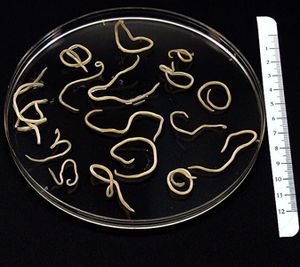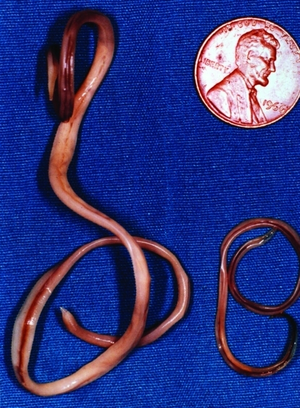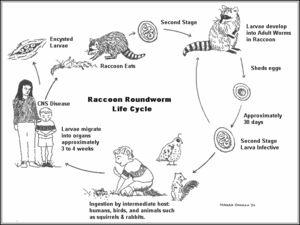Baylisascaris procyonis and Associated Diseases
Introduction and Phylogeny

By Nadia Torok
This is where my introductory paragraph will go. A citation example is posted below.
Latrine habits: [1]
This is a test, according to a source.[1]
The insertion code consists of:
Double brackets: [[
Filename: PHIL_1181_lores.jpg
Thumbnail status: |thumb|
Pixel size: |300px|
Placement on page: |right|
Legend/credit: Electron micrograph of the Ebola Zaire virus. This was the first photo ever taken of the virus, on 10/13/1976. By Dr. F.A. Murphy, now at U.C. Davis, then at the CDC.
Closed double brackets: ]]
Other examples:
Bold
Italic
Subscript: H2O
Superscript: Fe3+

Introduce the topic of your paper. What is your research question? What experiments have addressed your question? Applications for medicine and/or environment?
Sample citations: [2]
[3]
A citation code consists of a hyperlinked reference within "ref" begin and end codes.
Life Cycle
Include some current research, with at least one figure showing data.

Every point of information REQUIRES CITATION using the citation tool shown above.
Transmission, Risk Factors, and Treatment
will also include prevention in this section -- check out article about reducing B.p in latrines (Author = Page, in Emerging Infectious Disease)
socioeconomic risk factors: Hare paper.
Include some current research, with at least one figure showing data.
disease 1
Include some current research, with at least one figure showing data.
disease 2
Other Animals
Conclusion
References
- ↑ 1.0 1.1 Page, K.L., Swihart, R.K., and Kazacos, K.R. "Raccoon Latrine Structure and Its Potential Role in Transmission of Baylisascaris procyonis to vertebrates." 1998. The American Midland Naturalist 140(1):180-185.
- ↑ Hodgkin, J. and Partridge, F.A. "Caenorhabditis elegans meets microsporidia: the nematode killers from Paris." 2008. PLoS Biology 6:2634-2637.
- ↑ Bartlett et al.: Oncolytic viruses as therapeutic cancer vaccines. Molecular Cancer 2013 12:103.
Authored for BIOL 238 Microbiology, taught by Joan Slonczewski, 2017, Kenyon College.
